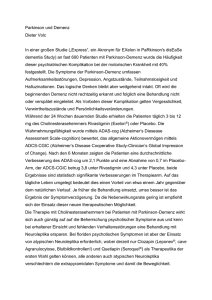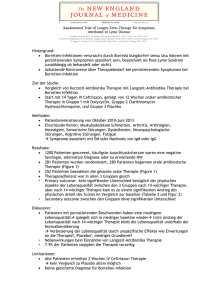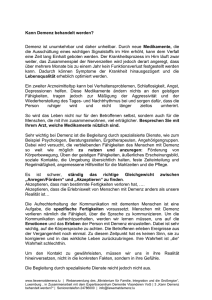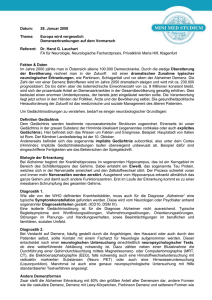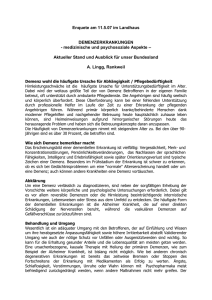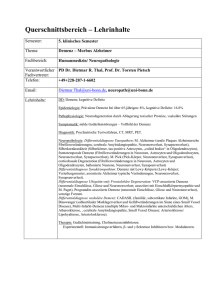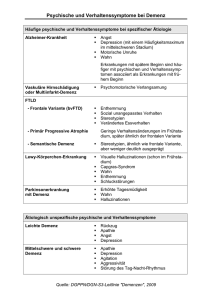Dresden_Nervenaerzte_Fortbildung05052011
Werbung
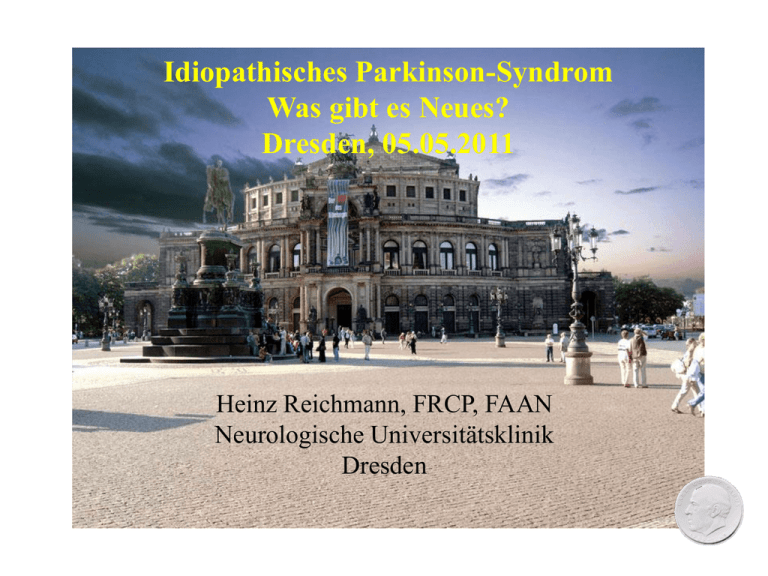
Idiopathisches Parkinson-Syndrom Was gibt es Neues? Dresden, 05.05.2011 Heinz Reichmann, FRCP, FAAN Neurologische Universitätsklinik Dresden Figure 2. Change in 18 F-Fluorodopa Uptake in the Brains of Patients with Parkinson ’s Disease after Transplantation,as shown in Fluorodopa PET Scans. Freed et al (2001) Li J-Y et al. (2008) Figure 2 a-synuclein–positive Lewy bodies in host substantia nigra and grafted dopaminergic neurons. Methods and Results Administration of rotenone intragastrically to one-year-old mice using a gastric tube Rotenone could not be measured by HPLC using blood and brain tissue There was no decrease in complex I activity in muscle and brain Rotarod test was used to show that there was a significant decrease in the rodents‘ ability to remain on the rod between 3 months treated mice and controls A-synuclein aggregation was only detected in treated animals A-synuclein aggregation was detected in the ENS and after longer periods in the intermediolateral nucleus in the spinal cord and the dorsal motor nucleus of the vagus After three months of treatment a-synuclein could be detected in the SN pars compacta combined with a 15% decrease in the number of TH-pos neurons OB and ENS are the only nervous system structures directly exposed to environmental substances Figure 2: Change in unified Parkinson’s disease rating scale part 3 score in the off state (A) Mean change from baseline for all patients with at least one assessment after surgery. (B) Mean change from baseline in the subgroup of patients who had masked visits after month 12 (n=30), with last observation carried forward for those who had completed assessments only to month 15 (n=16). Solid lines represent patients who were followed up for longer than 12 months. Dotted lines represent patients who were followed for only 12 months. Bars=SE. Marks WJ et al. (2010) Natürlicher Verlauf des IPS ohne Behandlung Diagnose ? Hyposmie REM Schalf-Verhaltensstörung Depression Obstipation Zeit Klinische Ratings Neuronenfunktion Symptomatisch Welcher Patient sollte behandelt werden? Uhrmacher Maurer Behandeln oder nicht behandeln ? PD-LIFE: multi-centre prospective audit-based study, on-going, N=198 PDQ-39 single index Deterioration 60 50 Treatment-naïve patients 40 Monotherapy with any anti-PD drug 30 20 10 0 Baseline 9 18 Follow-up period (months) Grosset. et al JNNP 2007; 78 (5): 465 Hauser RA et al. (2009) Hauser RA et al. (2009) ADAGIO: Studien Design 1 mg/Tag Frühe, unvorbehandelte ParkinsonPatienten (N=1,176) 1 mg/Tag Plazebo 2 mg/Tag 2 mg/Tag Randomisation 1:1:1:1 Woche -4-4 0 4 12 24 36wöchige doppelblinde Plazebo-kontrollosierte Phase 36 42 48 54 60 66 36wöchige doppelblinde Verum-Behandlungsphase 72 Figure 3. Changes in Scores on the Unified Parkinson’s Disease Rating Scale (UPDRS) in the Four Study Groups. The mean (±SE) change from baseline in the UPDRS score in the efficacy cohort for the second and third primary end points for patients receiving rasagiline at a dose of 1 mg per day (Panel A) and those receiving 2 mg per day (Panel B) are shown. The dashed lines indicate placebo, and the solid lines indicate rasagiline. ‘Floor’-Effekt in der UPDRS-Skala Nur symptomatisch Nur symptomatisch + KM Nur symptomatisch Symptomatisch + KM (Potenzielle Verbesserung (Potenzielle Verbesserung (Potenzielle Verbesserung (Potenzielle Verbesserung von X UPDRS-Einheiten) von X+Y UPDRS-Einheiten) von X UPDRS-Einheiten) von X+Y UPDRS-Einheiten) Arzneimittel X X Y Verbesserung Verschlechterung Arzneimittel Floor-Effekt Y Zeit Niedrigere UPDRS vor Behandlungsbeginn KM Wirkung ist nicht nachweisbar KM=krankheitsmodifizierend Zeit Höhere UPDRS vor Behandlungsbeginn KM Wirkung ist nachweisbar Schapira AHV et al., (2010) Movement Disorders, Vol. 25, No. 11 PROUD-Studie Delayed start Plazebo Schapira et al. (2009) Pramipexol Figure 2. 15-Month Time Course of UPDRS Total Score The ratings, by blinded study investigators, are graphed, with 95%-Cls, as mean change adjusted for baseline and country. Negative values signify improvement from baseline. Grosset et al. (2009) Ropinirol als “controlled release”Tablette (ReQuip-Modutab®) Monotherapie-Studie: Verbesserung des UPDRS Motor Scores nach Titrationsphase ReQuip ReQuip-MODUTAB 0 -2 Abnahme UPDRS Motor Score -4 -6 -8 -10 -8,9 n.s. -12 -10,4 Mittlere Änderung vs. Baseline (+/- 2 S.E.) Add-on-Studie: Signifikanter Therapieeffekt vs. Placebo ab Woche 2 Mittlere Änderung von Baseline zu Woche 24 in den “Off”-Zeiten im Wachzustand (ITT) 1.0 0.5 0.0 -0.5 -1.0 Placebo ReQuip-MODUTAB -1.5 -2.0 * -2.5 -3.0 -3.5 ** * * * * 1 2 3 4 = signifikant 6 8 10 12 Woche * 16 * 20 * * 24 24(LOCF) Schlaf unter ReQuip-MODUTAB verbessert 2 Adjustierte mittlere Veränderung gegenüber Baseline (Parkinson Disease Sleep Scale) +1,33 Verbesserung 1 Placebo 0 ReQuip-MODUTAB -1 -2 -3 Differenz: 4,66 Punkte p=0,0196 -4 –3,33 PDSS Score zu Baseline: ReQuip-MODUTAB 99,2 ; Placebo 98,0 in Validierungsstudie: Differenz zwischen Parkinsonpatienten und gesunden Gleichaltrigen ca. 20 Punkte Pahwa et al. Neurology 2007, Chaudhuri et al. JNNP 2002 RECOVER-Studie - Wirksamkeit Morgendliche Bewegungsstörungen (UPDRS III) und Schlafqualität (PDSS-2) 0 -1 -2 -3 -4 -5 -6 -7 -8 PDSS-2 1,9 (± 8,2) 3,9 Plazebo (n=96) Rotigotin (n=191) (± 7,3) 5,9 (± 7,6) 7,0 (± 7,6) -3,55 (LS-Mean) p=0,0002 Trenkwalder C. et al. Parkinsonism & Related Disorders 2009; 15:S136 16UCB data on file - p<0,0001 30 Verbesserun g Änderungen im UPDRS III bzw. PDSS-2 (FAS/LOCF) UPDRS III Watts RL et al. (2010) Aufbau der Hydrogel Matrix Hauser RA (2010) Hauser RA (2010) FIG. 2. UPDRS II 1 III scores over time (without and with L-dopa data censored). Piribedil-Eigenschaften – rote, linsenförmige, retardiert freisetzende Tabletten – Nichtergoliner Dopaminagonist – Wenig Oedeme – Evtl. bessere kognitive Leistungsfähigkeit – Wirkstärke 50 mg Stocchi F et al. (2010) FIGURE 1: Kaplan-Meier survival curves show that patients randomized to Ldopa/carbidopa/entacapone (LCE) had greater risk of developing dyskinesia than patients receiving L-dopa/carbidopa (LC) (Cox proportional hazard ratio, 1.29; 95% confidence interval [CI], 1.0 – 1.65; p = 0.038). Survival time estimates for the first quartile of patients were 90.7 weeks (95% CI, 65.3 –104.0) for the LCE group and 117.1 weeks (95% CI, 92.1 – 132.6) for LC-treated patients. Häufigkeit neuropsychiatrischer Symptome bei Patienten mit Parkinsonerkrankung (N=1.331) Demenz u. Psychose 9,02 % Depression u. Psychose 2,63 % alle drei Symptome 6,09 % keine neuropsych. Symptome 36,44 % Demenz u. Depression 10,82 % Psychose 2,25% Depression 17,81% Demenz 14,94% Riedel et al. 2006 Demenz bei Morbus Parkinson • Patienten mit Morbus Parkinson (Parkinson’s disease / PD) weisen häufig eine Beeinträchtigung der kognitiven Funktionen auf • Bis zu 40% entwickeln eine Demenz • Die Symptome der Demenz entwickeln sich nach den motorischen Parkinson-Symptomen • Dabei kommt es zu einer deutlichen Beeinträchtigung der Aufmerksamkeit und der exekutiven Funktionen sowie zu Gedächtnis- und Verhaltensstörungen • Die Demenz bei PD zeigt viele klinische und pathologische Gemeinsamkeiten mit der Lewy-Körperchen-Demenz (dementia with Lewy bodies / DLB) Gelb DJ et al. Arch Neurol 1999;56:33–9 Emre M. Lancet Neurol 2003;2:229–37 McKeith I et al Lancet Neurol 2004;3:19-28 Die Diagnose der Demenz bei PD Diagnostischer Ablauf: Diagnose von Morbus Parkinson (PD) Diagnose der Demenz (nach >1 Jahr motorischer Symptome) “Kognitive Defizite, die so schwerwiegend und umfassend sind, dass sie die DSM-IV-Kriterien für die Diagnose einer Demenz erfüllen” DSM-IV-Kriterien für eine Demenz: Multiple kognitive Defizite – Gedächtnisstörungen – Aphasie, Apraxie, Agnosie oder Störungen von exekutiven Funktionen Signifikante Verschlechterung gegenüber dem ursprünglichen Funktionsniveau Emre M. Lancet Neurol 2003;2:229–37 DSM-IV 2000 Kriterien für die klinische Diagnose Diffuse Lewy-Körperchen Erkrankung 1. Essenzielle Symptome • • • • • • • • progressives, kognitives Defizit das zu einer Beeinträchtigung sozialer oder beruflicher Kompetenzen führt eindeutige Beeinträchtigung mnestischer Funktionen in Anfangsstadien oder dominierend im weiteren Verlauf Aufmerksamkeitsstörung Dysfunktion des Frontallappens visuospatiale Defizite fluktuierende Intensität der Aufmerksamkeit und Vigilanz intermittierende visuelle Halluzinationen Parkinson-Syndrom mit Rigor, Ruhetremor und Akinese mit variablen Symptomdominanzen ähnlich wie bei Morbus Parkinson 2. Fakultative Symptome • • • • • • häufige Stürze in Anfangsstadien der Erkrankung Synkopen intermittierende Somnolenzen abnorme Sensitivität für Neuroleptika systematisierte Verkennungen nichtvisuelle Halluzinationen Halliday GM, McCann H (2009) Figure 3. Schematic representation of the progression of pathology in the three main clinical phenotypes of PD from longitudinal epoch data. Dopamine cell loss in the substantia nigra is represented as the solid color over the midbrain region, with darker colors indicating greater cell loss over time. Pink-colored brain stem Lewy bodies and brown-colored cortical Lewy bodies are represented separately. Larger lighter brown cortical plaques are also shown. Cholinerge Defizite bei der mit PD, DLB und AD einhergehenden Demenz 300 250 200 150 100 50 0 Kontrollen Demenz bei PD DLB AD Tiraboschi P et al. Neurology 2000;54:407–11 In einem 48-wöchigen Studienprogramm wurde die Wirksamkeit von Rivastigmin bei PDD bewiesen. EXPRESS Woche 0-24 Extensions-Studie Woche 25-48 Randomisiert Offene Verlängerungsphase Doppelblind Alle Patienten auf Rivastigmin Plazebo-kontrolliert 3-12mg Rivastigmin 3-12mg Rivastigmin Emre M et al. NEJM 2004; 351: 2509-2518 Poewe et al. Movement Disorders 2006; 21: 456-461 EXPRESS Woche 0-24 Extensions-Studie Woche 25-48 Änderungen von baseline, ADAS-cog Rivastigmin versus Placebo Effekte auf die kognitive Leistung (ADAScog) –2.5 –2.0 * ** Rivastigmin (n = 329) Placebo (n = 161) Verbesserung –1.5 –1.0 –0.5 Baseline 0 0.5 Verschlechterung 1.0 Woche: 0 16 24 *p = 0,002; **p < 0,001, ITT-RDO Analyse Emre M et al. NEJM 2004; 351: 2509-2518 Rivastigmin verbessert die Alltagskompetenz (ADCS-ADL) über 48 Wochen Veränderung vs. Baseline, ADCS-ADL 2 Doppelblind Phase Offene Verlängerung (alle Patienten erhalten Rivastigmin) 1.5 1 Verbesserung 0.5 0 Baseline -0.5 -1 -1.5 Rivastigmin Placebo -2 -2.5 Woche: 0 Rivastigmine, n = 180 Placebo, n = 99 16 24 48 177 99 178 96 171 95 Poewe et al. Movement Disorders 2006; 21: 456-461 Aarsland et al. (2009) Menza et al., Neurology 2009;72:886–892 Barone et al. (2009) Verhaltensstörungen bei M. Parkinson – Spielsucht (Molina et al. 2000) • • • • Internetspiele Automatenspiele TV-Shows Kasino – Hypersexualität (Vogel et al. 1983) • Libidosteigerung • Gesteigerte sex. Aktivität • Sex. Aggressivität • Punding • Stereotype, irrationale motorische Handlungen • Hyperphagie (Nirenberg et al. 2005) • Exzessives Shopping (Maja et al. 2003) • Andere Internetsurfen Sport Impulskontrollstörungen beim IPS Prävalenz •Weintraub et al. 2006 – ICS-Prävalenz 6,6 % •Voon et al. 2006 – ICS-Prävalenz • total 6,1% • DA-agonist 13,7% •Normalkollektiv 0,4-1% Danke für Ihre Aufmerksamkeit
